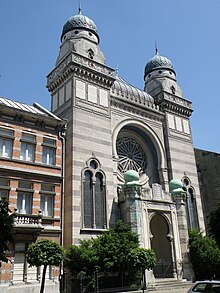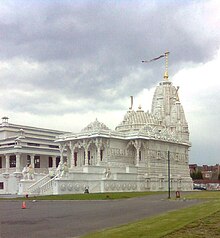User:Sackhy/sandbox
 | This is a user sandbox of Sackhy. You can use it for testing or practicing edits. This is not the sandbox where you should draft your assigned article for a dashboard.wikiedu.org course. To find the right sandbox for your assignment, visit your Dashboard course page and follow the Sandbox Draft link for your assigned article in the My Articles section. |
Minorities
[edit]This section needs expansion. You can help by adding to it. (June 2017) |
| Largest groups of foreign residents | |
| Nationality | Population (2011) |
|---|---|
| 38,884 | |
| 12,805 | |
| 1,938 | |
| 1,574 | |
In 2010, 36% to 39% of the inhabitants of Antwerp had a migrant background. In the city’s population register 13.3% of the population are registered as foreigners.[1] The two largest non-Belgian communities are the Moroccan and Turkish communities.[2] At least 166 different nationalities are present in the city.[3] The increasing amount of foreign nationalities is an indicator of the recent arrival of new migrant groups.[4] From 2015 to 2016, 72% of the babies born in Antwerp have a foreign background.[5] A study projects that in 2020, 55% of the population will be of migrant background.[6][7]

Jewish community
[edit]
There has been a Jewish presence in Antwerp as early as the 16th century. The Jewish community remained few in number until the 19th century — Antwerp contained several thousand Jewish residents until the Second World War.[8] Half of the foreign population of Antwerp in the late 1920s were Jewish.[9] After the Holocaust and the destruction of its many Jews, Antwerp became a major centre for Orthodox Jews. At present, about 15,000 Haredi Jews, many of them Hasidic, live in Antwerp. The city has three official Jewish Congregations: Shomrei Hadass, headed by Rabbi Dovid Moishe Lieberman, Machsike Hadass, headed by Rabbi Aron Schiff (formerly by Chief Rabbi Chaim Kreiswirth) and the Portuguese Community Ben Moshe. The presence of the Jewish community is noticeable by its clothing, grooming style, and various buildings that relate to the Jewish culture and identity.[10] Antwerp has an extensive network of synagogues, shops, schools and organizations. Tachkemoni, Yavne, and Yesode are three major Jewish schools in Antwerp that have grades starting from preschool through high school.[11] Among the Jewish community, 95% of the children are enrolled in Jewish schools.[12] Significant Hasidic movements in Antwerp include Pshevorsk, based in Antwerp, as well as branches of Satmar, Belz, Bobov, Ger, Skver, Klausenburg, Wiznitz and several others. Rabbi Chaim Kreiswirth, chief rabbi of the Machsike Hadas community, who died in 2003, was arguably one of the better known personalities to have been based in Antwerp. An attempt to have a street named after him has received the support of the Town Hall and is in the process of being implemented.[citation needed]
Jain community
[edit]
The Jains in Belgium are estimated to be around about 1,500 people. In the late 1950’s-1960’s, several Palanpuri Jain Indian families migrated to Antwerp seeking opportunity in the diamond business, this has now grown to 600 families.[13] The majority live in Antwerp, mostly involved in the very lucrative diamond business.[14] Belgian-Indian Jains control two-thirds of the rough diamonds trade and supplied India with roughly 36% of their rough diamonds.[15][citation needed] Within Antwerp, Jain community life is centrally located in the suburb of Wilrijk.[16] The first Jain temple on the European continent, as well as one of the biggest Jain shrines outside of India is the Shri Shankheshwar Parshvanath Jain Derasar is located in Wilrijk.[17] It contains a major temple and a cultural centre. Construction for the temple began in the late 90s; the style is a mix of traditional Eastern ideology and religious theology.[18] Mr Ramesh Mehta, a Jain, is a full-fledged member of the Belgian Council of Religious Leaders, put up on 17 December 2009.[citation needed]
Armenian community
[edit]There are significant Armenian communities that reside in Antwerp, many of them are descendants of traders who settled during the 19th century. Most Armenian Belgians are adherents of the Armenian Apostolic Church, with a smaller numbers are adherents of the Armenian Catholic Church and Armenian Evangelical Church.
One of the important sectors that Armenian communities in Antwerp excel and involved in is the diamonds trade business,[19][20][21][22] that based primarily in the diamond district.[23][24][25] Some of the famous Armenian families involved in the diamond business in the city are the Artinians, Arslanians, Aslanians, Barsamians and the Osganians.[26][27]
Muslim community
[edit]Antwerp contains a large Muslim community; one out of six of the population is Muslim.[28] As of 2016, roughly 18% of Antwerp’s population was Muslim.[29] In the 1960s, mostly men of Muslim backgrounds from Morocco and Turkey migrated to Antwerp.[30] The Moroccan and Turkish communities are the majority of the Muslim population, yet, there are also Muslims of Balkan, African, Asian and Mediterranean origin.[31] Most Muslims are concentrated in the urban center of the city.[32] As of 2008, there were 36 mosques in Antwerp.[33] It is estimated that 40% of all elementary school children in Antwerp are Muslim.[34] In a report from 2005, 41% of 495 Muslim youths between the ages of 15 and 25 said that they attend mosque at least once a month.[35]
References for Antwerp
[edit]- ^ "Housing and segregation of migrants - Case study: Antwerp, Belgium". Eurofound. Retrieved 2019-06-03.
- ^ Wauters, Bram; Eelbode, Floor; Celis, Karen (2011). "Ethnic minorities in local political parties: a case study of three Belgian cities (Antwerp, Ghent and Leuven)". 6th ECPR General Conference, Proceedings. Ghent University, Department of Political science. hdl:1854/LU-2988798.
- ^ "Antwerp". BAM - Becoming a Minority. Retrieved 2019-06-03.
- ^ TEXIER, Emmanuelle; VANDERWAEREN, Els. "Interuniversitary Consortium on Migration and Integration: Qualitative Research Part Migrants' Political and Social Participation in Belgium The case of Visé (Liège Province, Wallonia) and Antwerp (Antwerp, Flanders)". https://ec.europa.eu/. Retrieved 03/06/2019.
{{cite web}}: Check date values in:|access-date=(help); External link in|website= - ^ Hervé, Julie; Kajantie, Marianna (03/05/2016). "Study Visit Report in Antwerp" (PDF). http://wsdomino.eurocities.eu/eurocities/home. Retrieved 06/03/2019.
{{cite web}}: Check date values in:|access-date=and|date=(help); External link in|website= - ^ Auteur: Dajo Hermans. "56 procent van Antwerpse kinderen is allochtoon – Het Nieuwsblad". Nieuwsblad.be. Retrieved 12 March 2013.
- ^ "Antwerpen in 2020 voor 55% allochtoon" (in Dutch). Express.be. Retrieved 12 March 2013.
- ^ Gutwirth, Gutwirth (June 1968). "Antwerp Jewry Today". The Jewish Journal of Sociology: 121–137 – via https://hal.archives-ouvertes.fr/.
{{cite journal}}: External link in|via= - ^ Michman, Dan. "Why Did So Many of the Jews in Antwerp Perish in the Holocaust?" (PDF). www.yadvashem.org. Retrieved 06/04/2019.
{{cite web}}: Check date values in:|access-date=(help) - ^ Williams, Roman R. (2016-11-01). "Religion, Migration, and Change in a European City". Contexts. 15 (4): 48–57. doi:10.1177/1536504216685130. ISSN 1536-5042. S2CID 63992048.
- ^ "The Jewish Traveler: Antwerp". Hadassah Magazine. 2007-04-12. Retrieved 2019-06-08.
- ^ Akhmetov, Adil; Baker, Andrew (June 10-11 2013). "Country Visit: Belgium Report of the Personal Representatives of the OSCE Chairperson‐in‐Office on Tolerance and Non‐Discrimination Issues". Osce.org. Retrieved 06/08/2019.
{{cite web}}: Check date values in:|access-date=and|date=(help) - ^ Talsania, Rajesh; Jogani, Arun (May–June 2015). "Jain Digest" (PDF). Jain Digest. May-June 2015. Jain Association in North America: 60.
- ^ "An Introduction to Jainism: History, Religion, Gods, Scriptures and Beliefs". Commisceo Global. Retrieved 5 May 2012.
- ^ Daneels, Door Gilbert Roox, foto's Wim. "Diamant met curry". De Standaard (in Flemish). Retrieved 2018-10-28.
{{cite news}}: CS1 maint: multiple names: authors list (link) - ^ "Roots, Routes, and Routers: Social and Digital Dynamics in the Jain Diaspora". ResearchGate. Retrieved 2019-06-12.
- ^ Goddeeris, Idesbald; Cosemans, Sara (2013). "Indian migration to Belgium".
{{cite journal}}: Cite journal requires|journal=(help) - ^ "Into the next world | Flanders Today". www.flanderstoday.eu. Retrieved 2019-06-04.
- ^ Inside Knowledge: Streetwise in Asia p.163
- ^ Vanneste, Tijl (6 October 2015). Global Trade and Commercial Networks: Eighteenth-Century Diamond Merchants. Routledge. ISBN 9781317323372 – via Google Books.
- ^ Indians shine antwerp diamond centre polls International Business Times
- ^ Belgium Real Estate Yearbook 2009 p.23
- ^ Recession takes the sparkle out of Antwerp's diamond quarter |World news. The Guardian. Retrieved on 2 June 2011.
- ^ "Antwerp and diamonds, the facts - Baunat Diamonds". baunatdiamonds.com.
- ^ The Global Diamond Industry: Economics and Development, Volume 2 p.3.6
- ^ "THE ARMENIAN OF BELGIUM: AN UNINTERRUPTED PRESENCE SINCE THE 4TH CENTURY". AGBU - Armenian non-profit organization.
- ^ "Armenia: Report On Kotayk Province". WikiLeaks. 26 August 2011. Archived from the original on 14 March 2017. Retrieved 14 November 2012.
- ^ Whewell, Tim (2016-01-15). "Has Belgium created 'a system of apartheid'?". Retrieved 2019-06-03.
- ^ Teich, Sarah. "ISLAMIC RADICALIZATION IN BELGIUM".
{{cite journal}}: Cite journal requires|journal=(help) - ^ Muslims in Antwerp: At Home in Europe Project. New York: Open Society Foundations. 2011. ISBN 978-1-936133-05-5.
- ^ Loobuyck, Patrick; Petra, Meier (2014). "The imam in Flanders : a research note" (PDF). Retrieved 06/05/2019.
{{cite web}}: Check date values in:|access-date=(help) - ^ Bousetta, Hassan; Bernes, Laure-Anne. "Muslims in the EU: Belgium" (PDF). www.opensocietyfoundations.org. Retrieved 06/03/2019.
{{cite web}}: Check date values in:|access-date=(help) - ^ Waterfield, Bruno (2008-06-08). "Belgium's dwindling churches to be converted into mosques". Daily Telegraph. ISSN 0307-1235. Retrieved 2019-06-03.
- ^ Kern, Soeren (2012-11-09). ""Belgium Will Become an Islamic State"". Gatestone Institute. Retrieved 2019-06-03.
- ^ "Keeping Islam Pure in Europe | The Brussels Journal". www.brusselsjournal.com. Retrieved 2019-06-05.
Language
Venetian (Vèneto) is a Romance language that derived from Vulgar Latin.[1] Originating out of Latin in the north-east area of the (Italian) peninsula, Venetian grew organically and developed independently.[2] Also known as “dialeto del mar”, which means “dialect of the sea”, Venetian and Latin were the official languages of the Venetian Republic for a thousand years.[3] The Venetian dialect during the times of the Venetian Republic was used in official documents and was also the lingua franca of the Eastern Mediterranean.[4] With over four million people living in Veneto, most people there can understand Venetian, yet only about half or two million can speak the language.[5] Older Venetians use the language as much as possible, while the youth tend to only speak it with their families.[6] Various regional dialects of Venetian are spoken throughout Veneto; four dialects which developed in Venice can be heard in the city to this day.[7] Dialects in present-day Veneto, with the passing of time, have fused towards Venetian.[8] Speakers of various Veneto dialects mostly communicate verbally — it is not taught in school — children generally learn it in their homes.[9] There is no official Venetian writing system, generally the Italian orthography is substituted for writing.[10] The Veneto region has persistently tried to preserve its linguistic heritage by passing several laws. In 2007 the “Protection, development and promotion of the Venetan linguistic and cultural heritage” was passed.[11]
References for Venetian
[edit]- ^ "General Overview of the Venetan Language". www.orbilat.com. Retrieved 2019-05-03.
- ^ "Venetian Spoken Here". www.roderickconwaymorris.com. Retrieved 2019-05-03.
- ^ Piovesan, Lori. "Venetian dialect, the language spoken in". Venice Italy. Retrieved 2019-05-03.
- ^ "Interesting Facts about Veneto Italy: Noteworthy and Fun Info about Veneto". Veneto Explorer. Retrieved 2019-05-03.
- ^ "General Overview of the Venetan Language". www.orbilat.com. Retrieved 2019-05-03.
- ^ Falda, Adelia. "Perceptions of language change : a case study in Veneto". ir.library.oregonstate.edu. Retrieved 2019-05-05.
- ^ "Venessián, the Language of Venice". La Venessiana. 2016-07-23. Retrieved 2019-05-03.
- ^ Ferguson, R. (2003-10-01). "The Formation of the Dialect of Venice". Forum for Modern Language Studies. 39 (4): 450–464. doi:10.1093/fmls/39.4.450. ISSN 0015-8518.
- ^ Franchini, Sandro (2018-12-14), "Sulla storia dell'Istituto Veneto", Venezia 1868: l’anno di Ca’ Foscari, Storie dell'arte contemporanea, vol. 3, Edizioni Ca' Foscari, doi:10.30687/978-88-6969-294-9/009, ISBN 9788869692956, S2CID 188377739, retrieved 2019-05-03
- ^ "VENETIAN LANGUAGE - #DòparaElVèneto - 2. "Cofà ca scrivo?" Writing Venetian - Wattpad". www.wattpad.com. Retrieved 2019-05-03.
- ^ Coluzzi, Paolo (2008). "Language planning for Italian regional languages ("dialects")". Language Problems and Language Planning. 32 (3): 215–236. doi:10.1075/lplp.32.3.02col. ISSN 0272-2690.
